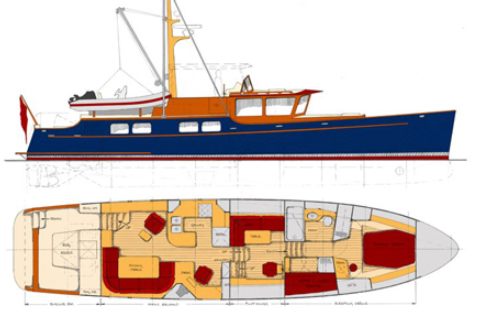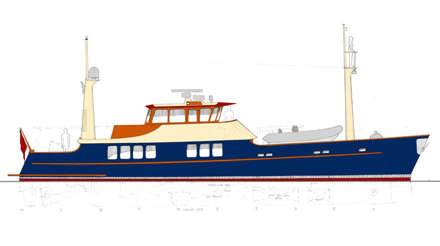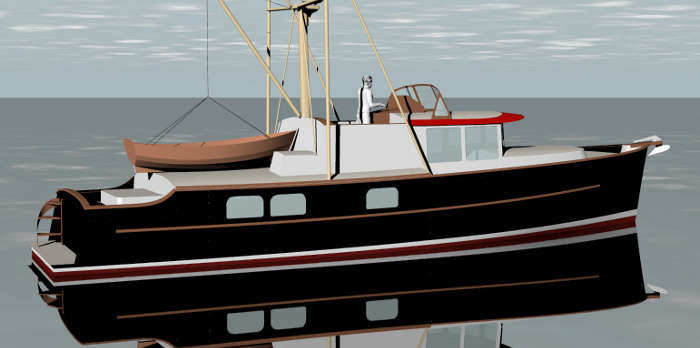Transport Efficiency (Et )
 Passagemaker Lite design series is Tad Roberts' modern, lightweight, fuel-efficient re-statement of the fast, seaworthy, long-range power cruiser. There are now two series, the orginal traditional one and a modern one, in lengths from 39' to 98'. Read more:
Passagemaker Lite design series is Tad Roberts' modern, lightweight, fuel-efficient re-statement of the fast, seaworthy, long-range power cruiser. There are now two series, the orginal traditional one and a modern one, in lengths from 39' to 98'. Read more:
-
Passagemaker Lite: Real vs. Theoretical Fuel Consumption During Ocean Crossings
The comparison of MPG without regard to either load (displacement/weight), or time (speed), seems an incomplete discussion. There is a very useful comparison of speed/power/weight called Transport Efficiency (Et ). With this coefficient, plotted against a dimensionless speed, we can compare the efficiency of displacement, semi-displacement, and planing hulls.
-
Transport Efficiency takes into account not just the power required (in effect MPG), but also the weight (displacement in the case of a boat) being moved, and the time required to move that weight (speed).
- Et = W * v / Pd * 550
- W is operating displacement, in pounds.
- v is speed in feet per second, (knots * 1.6889).
- Pd is the horsepower required for the above v.
For Rambler I guessed at a cruising weight of 1600 pounds. 6 miles per hour is 5.2 knots is 8.798 feet per second. I took the power as your stated 3.2 HP.
- Et = 1600 * 8.798 / 3.2 * 550
- Et = 7.998
Plot this against Volume Froude Number, (see WoodenBoat # 137)
- FNv = v / (g * disp.^.666)^.5
- v is speed in feet per second.
- g is acceleration due to gravity, (32.2)
- disp. is displacement, this time in cubic feet.
FNv for Rambler is .53 . This is about mid-range for displacement boats. Displacement hulls operate at a FNv of 1.3 or less, semi-displacement hulls at FNv of from 1.0 to 3.0, and planning hulls at FNv of 2.3 or more.
Piquant, designed by Francis Herreshoff and W.J. Strawbridge in 1950 was close to the ultimate in performance for a displacement hull. She was 47’ by 6’6” and double ended, displacement was 6700 pounds. Twin 35 HP gas engines burned 3 gallons of gas per hour for a cruising speed of 16 knots. Top speed was 20 knots. I calculate her top speed Et at 5.88 and FNv at 1.26. A fairly high speed is possible if the boat is very light.
In the early 1970’s Bill Garden designed Clam, which he termed a doomsday cruiser. She is 42’ by 8’ and of very simple vee-bottom plywood form. Her power was a Gray 4-69 gas engine, developing 15 HP @ 1800 RPM. Cruising displacement would be about 9300 pounds and she has bunks for 4, an enclosed head, and galley. Mr. Garden calculated a cruising speed of 6 knots using 10 HP, 1575 RPM, using one gallon of gas per hour. I calculate an Et of 17.13 at a FNv of .34. A big boat going very slow can be very efficient.
Another efficient hull is Phil Bolger’s Slicer, 29’ by 5’2”, a plywood vee-bottom hull of very light construction. Her displacement is about 1700 pounds and she achieved 18 knots with a 15 HP outboard. This is an Et of 6.26 but at a FNv of 1.79, which is well up into semi-displacement territory.
Running through the published figures for the Hinckley 29 I come up with an Et of 1.81 at a FNv of 2.11. This is below the efficiency of the best planning boats and also below the performance of her big sister, the 37’ Picnic Boat. This probably reflects the smaller boat’s higher beam/length ratio.
Looking at performance figures (37 mph for 200 HP) and guessing a weight of 5000 pounds for the Parker 23 gives some interesting results. I get an Et of 2.46 at a FNv of 2.23. This is better than the Hinckley and is probably a reflection of the greater propulsive efficiency from the outboard as compared to the waterjet.
The ultimate Et is a moving target as improvements are made in hull form and propulsive efficiency. I’m sure all the vessels above could exhibit improved Et with better underbody fairing, different propellers/gearboxes, and optimized forms.
-

PL 56 Specifications
- LOA: 56' 0"
- LWL: 55' 0"
- Beam: 13' 0"
- Draft: 3' 6"
- Displacement: 51,000 lbs
- Fuel: 1,100 US gallons
- Fresh Water: 400 US gallons
- Power: 2 John Deere 75 Horse Power 4045DFMs
- Speed: 11.5 knots (top), 10 knots (cruise), 8+ knots (ocean crossing)

PL 80 Specifications
- LOA: 80' 0"
- LWL: 76' 3"
- Beam: 17' 6"
- Draft: 5' 0"
- Displacement: 145,000 lbs
- Fuel: 4,400 US gallons
- Fresh Water: 600 US gallons
- Power: 2 Caterpillar 3306B 3355 Horse Power @ 2,200RPM
- Speed: 14.5 knots (top), 12.5 knots (cruise)
-

